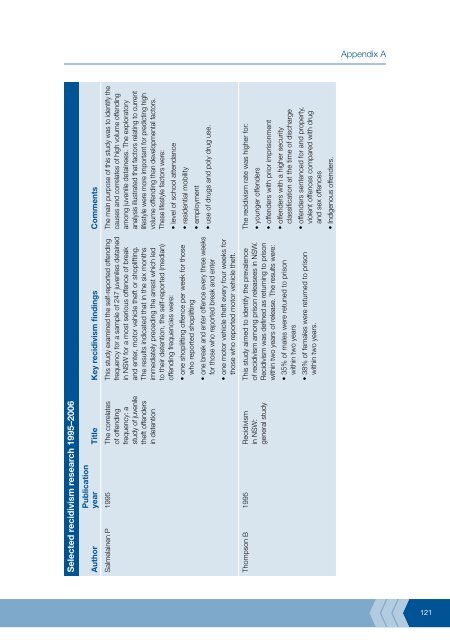Recidivism in Australia : findings and future research - Australian ...
Recidivism in Australia : findings and future research - Australian ...
Recidivism in Australia : findings and future research - Australian ...
Create successful ePaper yourself
Turn your PDF publications into a flip-book with our unique Google optimized e-Paper software.
Selected recidivism <strong>research</strong> 1995–2006<br />
Publication<br />
year Title Key recidivism f<strong>in</strong>d<strong>in</strong>gs Comments<br />
Author<br />
The ma<strong>in</strong> purpose of this study was to identify the<br />
causes <strong>and</strong> correlates of high volume offend<strong>in</strong>g<br />
among juvenile deta<strong>in</strong>ees. The exploratory<br />
analysis illustrated that factors relat<strong>in</strong>g to current<br />
lifestyle were more important for predict<strong>in</strong>g high<br />
volume offend<strong>in</strong>g than developmental factors.<br />
These lifestyle factors were:<br />
This study exam<strong>in</strong>ed the self-reported offend<strong>in</strong>g<br />
frequency for a sample of 247 juveniles deta<strong>in</strong>ed<br />
<strong>in</strong> NSW for a most serious offence of break<br />
<strong>and</strong> enter, motor vehicle theft or shoplift<strong>in</strong>g.<br />
The results <strong>in</strong>dicated that <strong>in</strong> the six months<br />
immediately preced<strong>in</strong>g the arrest which led<br />
to their detention, the self-reported (median)<br />
offend<strong>in</strong>g frequencies were:<br />
Salmela<strong>in</strong>en P 1995 The correlates<br />
of offend<strong>in</strong>g<br />
frequency: a<br />
study of juvenile<br />
theft offenders<br />
<strong>in</strong> detention<br />
• level of school attendance<br />
• residential mobility<br />
• employment<br />
• use of drugs <strong>and</strong> poly drug use.<br />
• one shoplift<strong>in</strong>g offence per week for those<br />
who reported shoplift<strong>in</strong>g<br />
• one break <strong>and</strong> enter offence every three weeks<br />
for those who reported break <strong>and</strong> enter<br />
• one motor vehicle theft every four weeks for<br />
those who reported motor vehicle theft.<br />
The recidivism rate was higher for:<br />
• younger offenders<br />
This study aimed to identify the prevalence<br />
of recidivism among prison releasees <strong>in</strong> NSW.<br />
<strong>Recidivism</strong> was def<strong>in</strong>ed as return<strong>in</strong>g to prison<br />
with<strong>in</strong> two years of release. The results were:<br />
Thompson B 1995 <strong>Recidivism</strong><br />
<strong>in</strong> NSW:<br />
general study<br />
• offenders with prior imprisonment<br />
• offenders with a higher security<br />
classification at the time of discharge<br />
• offenders sentenced for <strong>and</strong> property,<br />
violent offences compared with drug<br />
<strong>and</strong> sex offences<br />
• 35% of males were retuned to prison<br />
with<strong>in</strong> two years<br />
• 38% of females were returned to prison<br />
with<strong>in</strong> two years.<br />
• Indigenous offenders.<br />
Appendix A<br />
121















